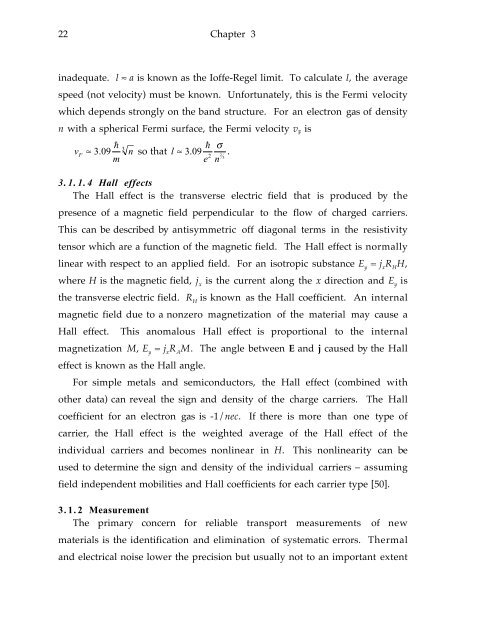MAGNETISM ELECTRON TRANSPORT MAGNETORESISTIVE LANTHANUM CALCIUM MANGANITE
MAGNETISM ELECTRON TRANSPORT MAGNETORESISTIVE LANTHANUM CALCIUM MANGANITE
MAGNETISM ELECTRON TRANSPORT MAGNETORESISTIVE LANTHANUM CALCIUM MANGANITE
Create successful ePaper yourself
Turn your PDF publications into a flip-book with our unique Google optimized e-Paper software.
22 Chapter 3<br />
inadequate. l ≈ a is known as the Ioffe-Regel limit. To calculate l, the average<br />
speed (not velocity) must be known. Unfortunately, this is the Fermi velocity<br />
which depends strongly on the band structure. For an electron gas of density<br />
n with a spherical Fermi surface, the Fermi velocity v F is<br />
v<br />
.<br />
F ≈ 309 3<br />
m n<br />
h<br />
h σ<br />
so that l ≈ 309 . 2 2 .<br />
3 e n<br />
3. 1. 1. 4 Hall effects<br />
The Hall effect is the transverse electric field that is produced by the<br />
presence of a magnetic field perpendicular to the flow of charged carriers.<br />
This can be described by antisymmetric off diagonal terms in the resistivity<br />
tensor which are a function of the magnetic field. The Hall effect is normally<br />
linear with respect to an applied field. For an isotropic substance E y = j x R H H,<br />
where H is the magnetic field, j x is the current along the x direction and E y is<br />
the transverse electric field. R H is known as the Hall coefficient. An internal<br />
magnetic field due to a nonzero magnetization of the material may cause a<br />
Hall effect. This anomalous Hall effect is proportional to the internal<br />
magnetization M, E y = j x R A M. The angle between E and j caused by the Hall<br />
effect is known as the Hall angle.<br />
For simple metals and semiconductors, the Hall effect (combined with<br />
other data) can reveal the sign and density of the charge carriers. The Hall<br />
coefficient for an electron gas is -1/nec. If there is more than one type of<br />
carrier, the Hall effect is the weighted average of the Hall effect of the<br />
individual carriers and becomes nonlinear in H. This nonlinearity can be<br />
used to determine the sign and density of the individual carriers Ð assuming<br />
field independent mobilities and Hall coefficients for each carrier type [50].<br />
3. 1. 2 Measurement<br />
The primary concern for reliable transport measurements of new<br />
materials is the identification and elimination of systematic errors. Thermal<br />
and electrical noise lower the precision but usually not to an important extent
















